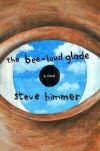 Steve
Himmer: The Bee-loud
Glade. Kensington, MD: Atticus Books, 2011.
Steve
Himmer: The Bee-loud
Glade. Kensington, MD: Atticus Books, 2011.
Himmer's first novel is a tale of a modern ornamental hermit. The premise may be abrupt for the modern reader. The maintenance of an ornamental hermit was the practice of some wealthy 18th-century English landholders who decorated their grounds with a live-in hermit, for the bemusement of the landholder and curious visitors. Specifications for the contract usually included long hair, uncut beard, untrimmed nails, a medieval-looking robe, and a vow of silence. Such is historical fact.
But however a writer may update the decorative hermit, postmodern literary critics will perceive such hermits as a variant literary type: quirky character plopped into strange setting or, alternatively, the topic of light reading and tour de force. Himmer's challenge is authenticity combined with obliqueness, to simultaneously charm contemporary readers unfamiliar with hermits, and not tax their grounded sense of probability, while being true to the psychology of his protagonist. Himmer navigates the course wonderfully.
The first-person narrator Finch is decidedly contemporary -- an office denizen working for an artificial plant company, a blogger with multiple online personalities. He is bored and rootless, echoing classic modern office functionaries from Kafka to Pessoa, without the pall of their intensity. Fired at last, Finch retreats to his dark apartment in social isolation and increasing indifference to the threat of eviction and penury.
Such is the world-weariness of the modern mind, vaguely aware of the world, sensing a background of rapacity, a life of artificiality, imminent collapse inducing helplessness. But perhaps that takes the novel too seriously? As already suggested, Himmer's tale is not ponderous existentialism or postmodern complexity. Light, bemusing, and humorous are some of the critics' adjectives. Thus Himmer's novel can work both ways, like the sides of a coin. The book is filled with allusions to hermits, a gift to those familiar with the history of eremitism. Those not familiar can simply enjoy a good yarn (though they won't know what they're missing).
But all readers can enjoy the adventures and mishaps of the decorative hermit, his willful and whim-driven boss Crane, and a crew of motley if occasional interlopers. Or reflect on the possibilities in Finch's mind and heart, his growing self-understanding, his modest philosophizing, his ability to coexist with his natural environment. Like a displaced urban Siddhartha, Finch learns from the river to think, wait, and fast -- fast, that is, from modern life.
Let go of the "decorative" part and identify what it means to be a true hermit, as Finch does, and the modern reader might wonder about the mind and preconditions of solitude and sustainability. In this regard, the critics only know Thoreau and safely conclude that he was kidding. They always knew, they tell one another with a wink, that Thoreau would come back to civilization as we know it. Except that Himmer's narrator Finch does not. Not just because of the circumstances of his wealthy patron or an untold collapse around him, but because the life he has led as a hermit is what he really wants, is all that matters.
Poignant, empathetic, humorous, and a solid tale for
sustained interest, The
Bee-loud Glade is a satisfyingly modern novel, with a protagonist
full of foibles but who grows before us in quiet wisdom.
I will arise and go now, and
go to Innisfree,
And a small cabin build there, of clay and wattles made;
Nine bean rows will I have there, a hive for the honeybee,
And live alone in the bee-loud glade.
-- from "The Lake at
Innisfree" by William Butler Yeats
¶
